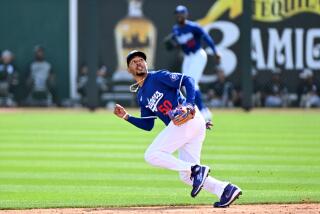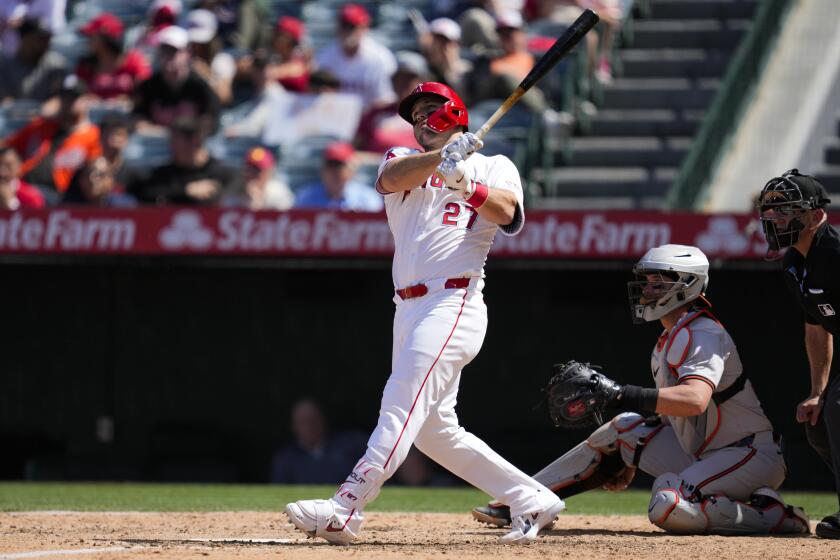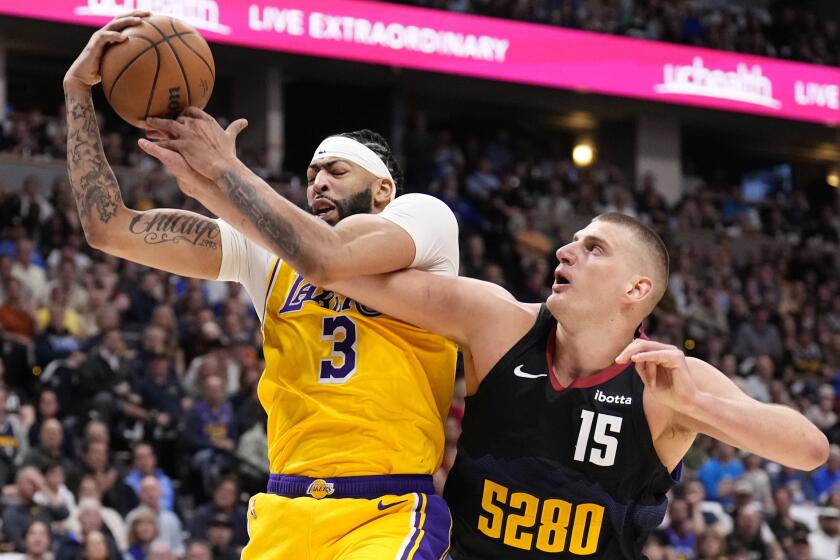Dodgers’ Moon found success in Coliseum
It seemed like the worst kind of trade, one that favored neither team, a deal best left in the small print on the transactions page.
A half century ago, the Dodgers sent Gino Cimoli to the St. Louis Cardinals for Wally Moon, an exchange of outfielders, both of whom were coming off years in which they batted below .250. The Cardinals also tossed in pitcher Phil Paine, never to be heard from again.
FOR THE RECORD:
Baseball: A caption in Sunday’s Sports section with a photograph showing the configuration of the field in the Coliseum for Saturday’s baseball game between the Dodgers and the Boston Red Sox said a screen down the short left-field line would be 6 feet high. The screen will be 60 feet high. —
This was how the Dodgers planned to recover from their seventh-place finish in 1958?
Moon batted .238 in his last season in St. Louis with seven home runs and 38 runs batted in in 108 games. He had been hampered because of an injured left elbow, suffered in a collision with fellow outfielder Joe Cunningham. Damaged goods, or player on the mend? Dodgers general manager Buzzie Bavasi took a gamble.
To make matters even more problematic, Moon was a left-handed batter coming to the Coliseum, a graveyard for those swinging from that side of the plate. The outfield fence in the power alley in right field was 440 feet away. It was where fly balls went to die. In 1958, the Dodgers’ first season in the Coliseum, 193 home runs were hit, only eight to right. In contrast, the left-field seats were only 251 feet away, inadequately protected by a 42-foot high screen.
“I was coming off a rough year,” said Moon, now 77 and a resident of Bryan, Texas, where he has lived for the last quarter century. “And I was a little upset knowing I was going to a place where they stacked the lineup with right-handed hitters to take advantage of that screen. I wasn’t sure how much I would get to play.
“I went to my old teammate, Stan Musial, a great friend and mentor. He set me down and told me I could use that screen to my advantage. He reminded me I had shown the ability to hit to all fields. I was just going to have to put more emphasis on hitting to left. With encouragement from him, I vowed to find a way to do that.”
Moon enjoyed challenges. When he joined the Cardinals in 1954, he replaced a St. Louis legend in the outfield, Enos Slaughter. In Moon’s first major league at-bat, he was greeted by fans chanting, “We want Slaughter!”
Moon responded by hitting a home run. He went on to become National League rookie of the year, beating out, among others, a Milwaukee Braves outfielder named Hank Aaron.
It seemed ordained Moon would become an athlete. Born in Bay, Ark., he was named Wallace Wade Moon after the former Duke and Alabama football coach who twice led teams to the Rose Bowl. But Moon also came from a family with a teaching background. He earned a master’s degree in administrative education from Texas A&M while he was still in the minor leagues.
With his elbow improved, Moon, on his arrival to the Coliseum, combined his intelligence and athleticism to develop the technique that would result in what became known as “Moon shots” a decade before Neil Armstrong took his giant leap for mankind. Leaving opposing pitchers gnashing their teeth and left fielders scraping their backs against that annoying screen, Moon used an inside-out swing to pop home runs over the left-field barrier, not to mention a barrage of singles and doubles that rattled off the mesh surface.
“I knew pitchers in the Coliseum threw inside to left-handed hitters, hoping to get them to hit to right or center where they couldn’t get the ball out very often,” Moon said. “What I did was to get my hands inside of the ball, leading the bat through and extending it for power. It was an educated slice. I tried to hit the bottom half of the ball to produce the high fly balls. That was not exactly the way I was taught to hit. You’re supposed to stay on top of the ball to hit line drives.”
In a year in which he bounced back to bat .302, Moon hit 19 home runs, 14 at the Coliseum, nine of those over the screen. None was more dramatic than the Moon shot of Aug. 31, 1959.
Facing the San Francisco Giants, Sandy Koufax had struck out 18 through nine innings to tie the major league record. But the score was still tied, 2-2, when Moon came up in the bottom of the inning against reliever Al Worthington with two runners aboard. He launched a game-winning Moon shot, a towering drive that ignited a heart-pounding roar considering the crowd that night was 60,194.
“It was unforgettable,” Moon said. “I can still hear it, still feel it, still see it after all these years.”
Moon not only had to learn how to master the looming screen when he was facing it at home plate but also when his back was against it as the left fielder.
“The fans were right behind you,” he said. “I heard a lot of encouragement. But it was a tough thing to play there defensively. Your natural instinct as an outfielder is to move to the ball. But in the Coliseum, you had to stand still and let the ball come to you. It could be a mess out there, the ball coming off that screen in all sorts of different directions. There was no real certainty.”
The Dodgers went on to win the World Series in 1959, validating Bavasi’s judgment.
Moon quickly came to love his new city.
“For a boy from Arkansas,” he said, “L.A. will wake you up.”
When the Dodgers left the Coliseum for Dodger Stadium after the 1961 season, Moon, naturally, scored their final run.
He played on three World Series championship teams with the team before they released him at the end of the 1965 season.
Moon went on to become athletic director and baseball coach at John Brown University, a coach and minor league manager and owner of the San Antonio Dodgers for four years beginning in the late 1970s.
He retired 10 years ago to spend more time with his wife, Bettye, his five children and seven grandchildren, his free time revolving around quail hunting and golf.
For his family, the special moments extend well beyond Moon shots. When his daughter, LaRhesa, was named homecoming queen in high school, she still remembers her father’s words: “This is better than any home run I ever hit.”
Moon will be back in the Coliseum on Saturday for the Dodgers’ exhibition game against the Boston Red Sox, a game expected to draw a record 115,000 fans.
He was there for the previous record crowd, 93,103, for a 1959 exhibition game against the New York Yankees, highlighted by a candlelight tribute to the paralyzed Roy Campanella.
“I don’t know if I ever wept at a ballpark before,” Moon said, “but I did that night.”
When he returns Saturday, might there be a launching of one more Moon shot in batting practice?
“I haven’t picked up a bat in 30 years,” he said, “but I’ll take a shot at it. I still play a lot of golf so I might be able to get it there.”
While the distance to left will be only 201 feet Saturday, the screen will be 60 feet high.
“Well then,” Moon said, “I’ll just have to get under it a little bit more.”
More to Read
Get our high school sports newsletter
Prep Rally is devoted to the SoCal high school sports experience, bringing you scores, stories and a behind-the-scenes look at what makes prep sports so popular.
You may occasionally receive promotional content from the Los Angeles Times.






